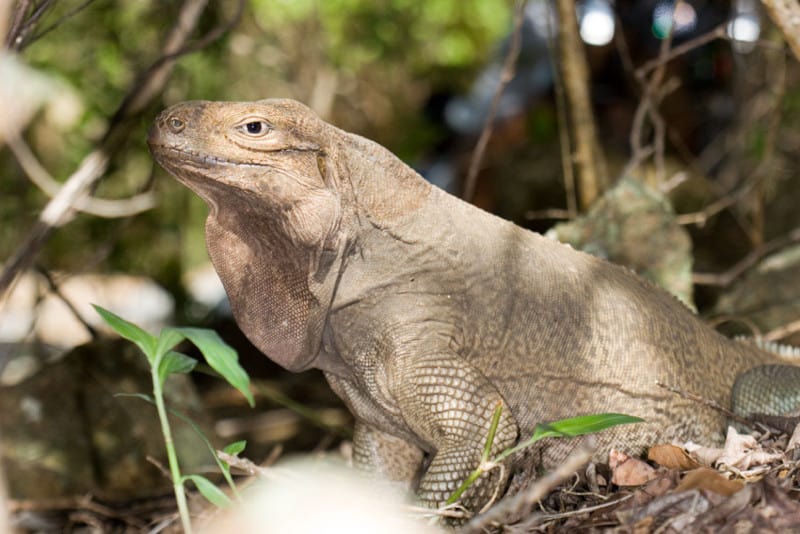Anegada ground iguana Facts
- Although attention-grabbing, Anegada ground iguana serves as only one of the common names for this remarkable reptile. It’s also known by the alternate term of stout iguana. For the moment, no other alternate common names for the fascinating lizard.
- The official scientific name for the creature, meanwhile, remains that of the Cyclura pinguis. It also represents one of only nine recognized members of this impressive genus. Several subspecies do exist, however, all of which live in the same general region.
- Perhaps even more impressively, the first recognition of it as a distinct species did not occur until modern times. More precisely, this occurred in 1917. The American herpetologist Thomas Barbour made the first recorded description of it at that time.
- Most unfortunately, the known population of the Anegada ground iguana numbers only around 300 individuals. That number represents a decrease of roughly 80% in the last 40 years. The IUCN, therefore, now lists the reptile as Critically Endangered.
- Conservation efforts remain underway. These include such tactics as relocating a small group of 8 individuals to another location, in the 1980’s. For the moment, that colony appears to be increasing in number, albeit slowly, with a total of 20 adults known.
- The principal cause of its decline in its native area in modern times consists of competitive grazing by livestock. Given its numbers, however, it must also be considered to be threatened by other factors, such as the danger of climate change.
Related Articles
Anegada ground iguana Physical Description
While it’s impressive in many ways, the Anegada ground iguana does not stand out in terms of physical size. That’s due to the simple fact that, in that respect, at least, it qualifies as roughly average-sized. It nonetheless merits its own quantities of respect and appreciation.
It also displays a moderate degree of the physiological characteristic of sexual dimorphism. In this regard, it follows the pattern of all other known members of its genus. In its specific case, though, this trait manifests itself in terms of its overall physical appearance.
This characteristic further does so in not just one, but several separate ways. The first, and perhaps most easily noticeable, is that of sheer size. More specifically, males of this fabulous species generally develop as slightly larger in size than their female counterparts.
Males attain an average body length of about 22 in (56 cm). Though the females remain shorter, the difference isn’t extreme. The tail, like many related species, develops relatively long. In point of fact, this appendage averages nearly as long as the body itself.
Adults typically display a farily uniform brownish-black or grayish color. Varying degrees of turquoise also appear on the tail base, dorsal spine, and legs. Females, though, generally manifest somewhat more subdoed color patterns, with less of the turquoise color.
The genders of the Anegada ground iguana also differ in appearance in yet more ways. Among these is the fact that males have more prominent dorsal crests. The males also possess special pores on the thighs, which they use to release special pheremones.
- Kingdom: Animalia
- Phylum: Chordata
- Class: Reptilia
- Order: Squamata
- Family: Iguanidae
- Genus: Cyclyra
- Species: C. pinguis
Anegada ground iguana Distribution, Habitat, and Ecology
Unfortunately, the Anegada ground iguana evolved as native to a highly isoloated and remote portion of the globe. More precisely, it lives in a region that lies about 80 mi (130 km) northeast of Puerto Rico. In fact, its home forms part of the British Virgin Islands.
Historically, this marvel of Nature lived on a total of 4 islands in the chain. Those consisted of Puerto Rico, Saint Thomas, Guana, and Anegada. Now, though, the reptile only appears naturally on the island of Anegada. The small man-made colony now inhabits Guana.
The natural habitat of this lizard itself qualifies as unusual in its region. That’s because, unlike the majority of islands in the area, it’s not volcanic in origin. In fact, it’s actually formed of a combination of limestone and coral! This creates a very specific type of habitat.
Numerous natural tunnels and caves appear throughtout the entirety of the island. Typically, individuals live in the same area for life. Most, therefore, mate with others of the species living in the same immediate area. The majority also appear to mate for life.
The natural diet of the Anegada ground iguana is mainly herbivorous. Its natural diet typically includes such things as flowers, fruits, and leaves from local plants. Sadly, though, the presence of large numbers of livestock now present has altered that diet.
Individuals have been forced to consume those plants the livestock avoids. Most have now become oportunistic carnivores. This new diet, now omnivorous, largely includes millipedes, roaches, centipedes, various insects, and other small invertebrates.
This artificially imposed dietary shift has had a negative impact on its reproduction. Most females now lack sufficient nutrients to produce eggs and survive. In fact, many perish shortly after laying their eggs. Due to this, males now outnumber females 2 to 1.
Species Sharing Its Range
Check out our other articles on 4 Refreshingly Remarkable Rivers, Chinese Giant Salamander, Chandipur Beach, Oribi, Pink Flannel Flower, Green Milkweed Grasshopper, Hermann’s Tortoise

